How to Troubleshoot & Fix MacOS Mojave Wi-Fi Issues
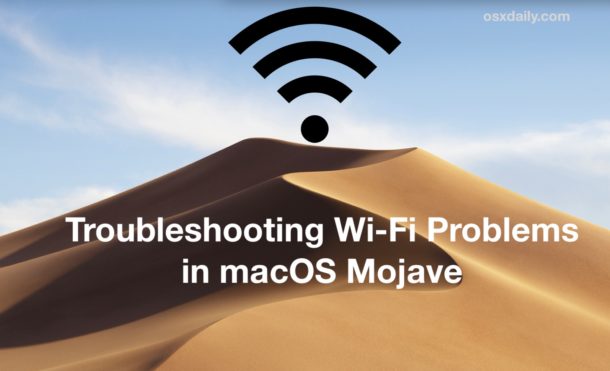
Have you been experiencing wi-fi problems since installing MacOS Mojave 10.14 on a Mac? While MacOS Mojave works great for most Mac users with compatible Macs (and even for many Macs that are unofficially able to run Mojave), a small number of MacOS Mojave users have discovered that wireless networking is having difficulties for them. Typically the Mojave wi-fi issues are that the connection has either failed, drops frequently, won’t reliably connect to wi-fi, is unable to connect at all, or even that general wi-fi performance is suffering, and the symptoms appear to have arrived only after updating a Mac to macOS Mojave.
This troubleshooting guide will aim to troubleshoot and resolve wi-fi problems and issues with MacOS Mojave.
Troubleshooting Wi-Fi Problems with MacOS Mojave
We’ll walk through a variety of steps to troubleshoot wireless networking issues on the Mac. Some of these are fairly simple, while others are more complex and require setting up new network profile information, moving system files, using custom network configurations, and other techniques that typically resolve wireless.
Important: Back up the Mac before going any further. This is essential because some of the troubleshooting steps involves accessing and removing system level configuration files. A full system backup is essential so that you can restore from if something goes haywire, and to prevent data loss. Backing up a Mac with Time Machine is easy, don’t skip it.
Install Available Software Updates, & Reboot the Mac
It’s always a good idea to keep system software up to date, and thus your first step should be to check for any available system software updates and install them if applicable.
You can check for and install system software updates in macOS by going to the Software Update control panel in “System Preferences”. Be sure to backup your Mac before installing any system software update.
If you do not have any system software updates available, go ahead and restart the Mac anyway, as sometimes a simple reboot remedies wi-fi and network issues.
Disconnect USB 3 / USB-C Devices, Docks, Hubs, etc from the Mac
If your wi-fi works but is frequently dropping, unable to connect, operates extremely slow, or is nearly useless, a possibility exists of hardware interference with certain USB 3 or USB-C devices and the Mac. This is because some USB devices emit radio frequency that can interfere with wireless networking.
Yes this sounds strange, but apparently some users are discovering that certain USB 3 and USB-C docks, hubs, and adapters are interfering with their wi-fi performance, typically on the newer model MacBook and MacBook Pro computers, but it can impact other machines as well.
An easy way to check if this applies to you and your wi-fi issues is to disconnect any connected USB 3 or USB-C devices, docks, hubs, or adapters from the Mac.
If the wi-fi connection works fine with the USB device disconnected, then you have likely found the culprit for your wireless network issues. If the USB cable is long enough, you can try moving the USB device further away from the computer itself so that nearby interference is minimized.
Some users report that changing the network connection from 2.4ghz to 5ghz can fix this issue, or getting a higher quality shielded USB hub may make a difference too.
For what it’s worth, this same USB interference issue can impact Bluetooth performance as well.
Make a New Wi-Fi Configuration in MacOS Mojave
These steps will walk through removing existing wi-fi configuration files to create new ones, which often resolves network problems on a Mac. Here’s what you’ll need to do:
- Back up your Mac first if you have not done so already – do not skip making a backup
- Pull down the Wi-Fi menu bar item in the upper right corner of the screen and choose “Turn Wi-Fi Off” to temporarily disable wi-fi on the Mac
- Now go to the Finder, and in any easily accessible location (Desktop, Documents, etc), make a new folder named something obvious like “WiFi Backup Files”
- Next, pull down the “Go” menu in the Finder and choose “Go To Folder”
- Enter the following path in Go To Folder then select “Go”
- Locate and select the following files in the SystemConfiguration folder
- Select those files and move them to the “WiFi Backup Files” folder you made a moment ago
- Now pull down the Apple menu and choose “Restart”, this will restart the Mac
- After the Mac boots back up, click on the Wi-Fi menu in the upper right corner again, this time selecting “Turn Wi-Fi On”
- Join the wireless network as usual by finding the wi-fi access point in the Wi-Fi menu
/Library/Preferences/SystemConfiguration/
NetworkInterfaces.plist
com.apple.wifi.message-tracer.plist
com.apple.airport.preferences.plist
preferences.plist
Now try using the internet again as usual, by opening Safari and visiting your favorite website (which is osxdaily.com obviously!). Wireless networking should work fine for most Mac users at this point.
If you continue to have problems with wireless networking and wi-fi, proceed to the next troubleshooting method.
Create a New Network Location with Custom Settings
Detailed below is how to create a new network location using custom configuration settings for DNS and MTU, this can often resolve finicky network issues on the Mac (and other hardware for that matter).
- Quit out of any open app that uses the internet (Safari, Mail, Messages, Chrome, Firefox, etc)
- From the Apple menu, choose “System Preferences”
- Choose the “Network” panel, then choose “Wi-Fi”
- Pull down the “Location” menu and select “Edit Locations” from the dropdown menu
- Click the [+] plus button to create a new network location, give it an obvious name like “FixWiFi” then click on “Done”
- Pull down the dropdown menu next to “Network Name” and choose the wi-fi network to join, then enter the wi-fi password if necessary
- Now click on the “Advanced” button, seen in the corner of the ‘Network’ preference panel
- Click the “TCP/ IP” tab and now click on “Renew DHCP Lease”
- Now select the “DNS” tab, and within the “DNS Servers” area click on the [+] plus button to add the following IP addresses as one entry per line:
- Now choose the “Hardware” tab and set ‘Configure’ to “Manually”
- Adjust “MTU” to “Custom” and set the number to “1491”
- Click “OK” to accept the MTU changes
- Click “Apply” to set the network changes for the new network location
- Exit out of System Preferences
- Finally, open Safari, Firefox, or Chrome, and try to visit a website like https://osxdaily.com where it should load fine
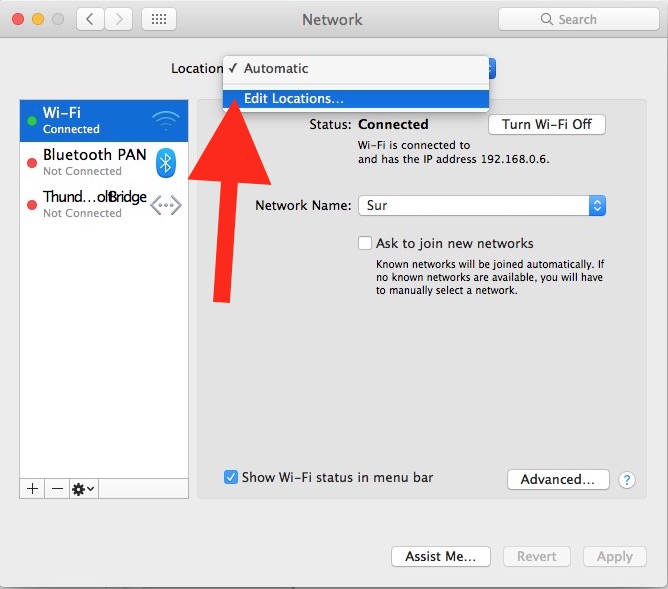
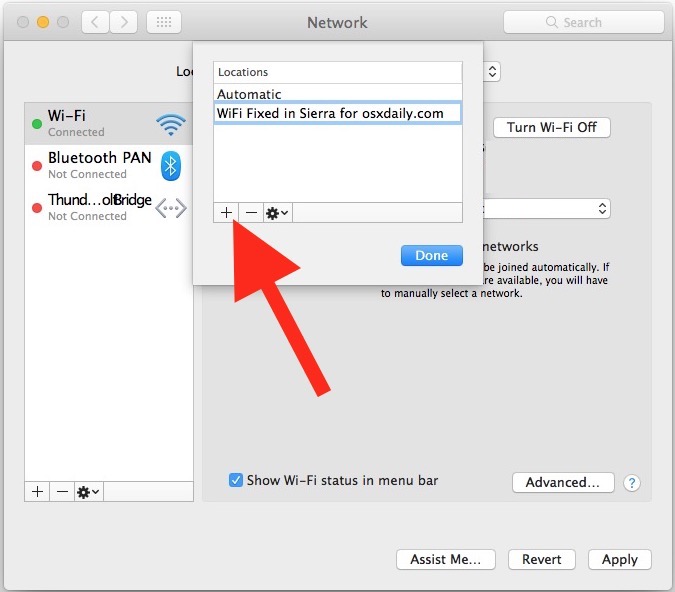
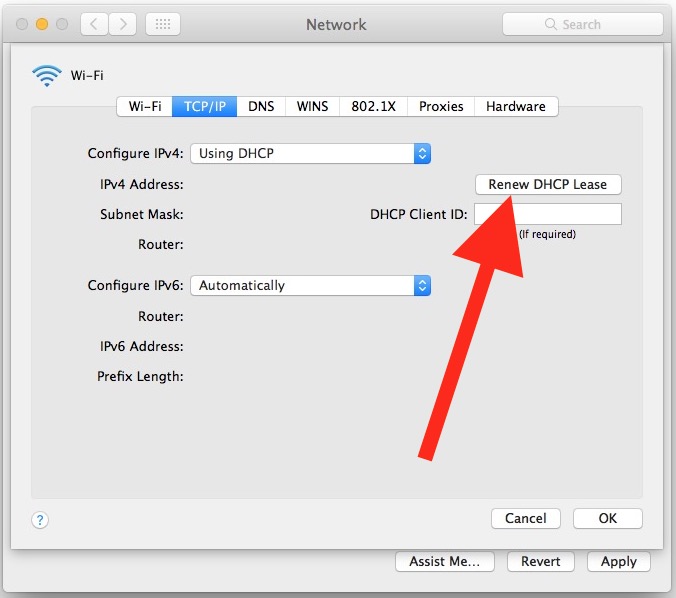
8.8.8.8
8.8.4.4
(Note these IPs are Google DNS servers, but you can use CloudFlare DNS or OpenDNS or others if desired)

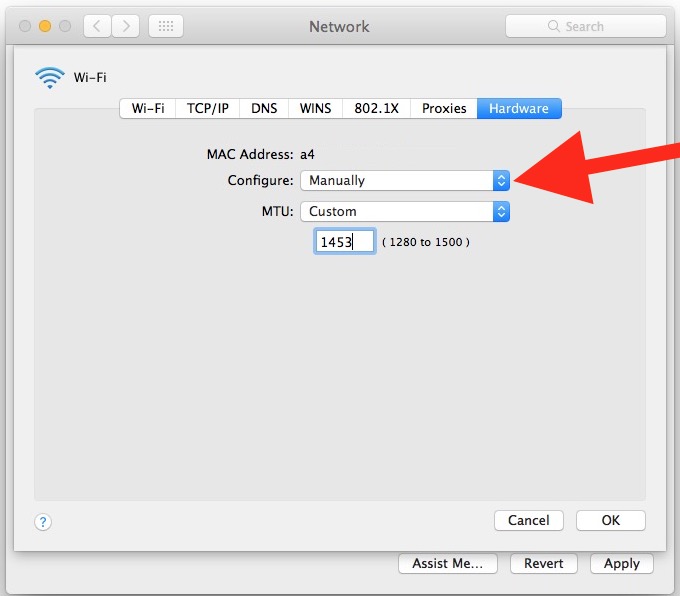
This series of steps involving trashing wi-fi preferences to create new ones and using a new Network Location with defined DNS and MTU settings are some of the most consistent means of resolving software based wi-fi issues on the Mac. We’ve covered similar troubleshooting steps for wi-fi problems with other versions of Mac OS, including for High Sierra, Sierra, El Capitan, and many releases before, because it almost always works.
Reset the Wi-Fi Router / Modem
If you’re having problems with a particular wi-fi router and/or modem, try resetting the router and modem. Usually this just involves unplugging the router and modem for about 20 seconds, then plugging them back in again.
The exact process of resetting routers and modems can vary per manufacturer, and thus it would be impossible to cover all of the options here. If you’re not sure how to troubleshoot wi-fi network issues that are directly related to the wi-fi router and modem (cable, DSL, fiber, dial-up, etc), then contact your ISP for their technical support guidance.
Additional Wi-Fi Troubleshooting Steps
- Try re-installing MacOS Mojave system software, which will reinstall just the core operating system without changing user files (assuming the procedure is done properly)
- Reset the SMC
- Reset the NVRAM / PRAM on the Mac
- Follow specific instructions for fixing the “No hardware installed” error with Mac Wi-Fi
- If all else fails, a radical approach can be to downgrade MacOS Mojave to a prior version of system software if backups are permitting
–
For what it’s worth, almost every single MacOS system software update seems to cause a small number of Mac users some wi-fi grief, and in most cases it’s just a matter of a corrupted plist file, a DHCP or DNS issue, or something fairly simple to resolve. This is no different with the MacOS Mojave 10.14 update (and even the 10.14.x updates), and so while the vast majority of Mac users will experience no difficulty with wireless networking and the software updates, some issues can crop up for small numbers of Macs. The good news is that it’s usually a simple resolution.
Did the above troubleshooting steps resolve your wi-fi problems in MacOS Mojave? Did you find another solution to your wireless networking issues? Share with us your thoughts, experiences with troubleshooting, and solutions for fixing wifi difficulties, by leaving a comment below!


Hi, very grateful for this guide, especially the tips about some USB-C devices interfering with Wi-Fi. Whilst I was reading the guide I ran Onyx from Titanium software – I use it a lot and iot solves a lot of issues, including this one.
I’ll be saving that guide though
– one thing, you wrote
“Adjust “MTU” to “Custom” and set the number to “1491””
but the image shows “MTU” set to “Custom” and “1493”
is either OK?
My older version of Mac OS Mojave was easily fixed with:
/Library/Preferences/SystemConfiguration/
Locate and select the following files in the SystemConfiguration folder
NetworkInterfaces.plist
com.apple.wifi.message-tracer.plist
com.apple.airport.preferences.plist
preferences.plist
and deleting them. But no more. With 10.14.6 (18G103) update, I can’t locate those files. I’m afraid to update further. Mac OS Catalina was horrible. Big Sur is great except it interferes with my discrete graphic’s card and slows processing videos and games.
After over a decade of wireless problem with MacCrap, beginning in Snow Leopard, believe it or not, I have found that the best, most consistent and reliable way to solve MacJunk wifi problems is to simply go to a different OS. Yes, even Windows. Windows may be bloated crap, but at work or at home I have never ever had wifi problems like I have on Mac.
The coolness of Macs and Starbucks may be unchallenged among the hipster crowd, but I need mine to actually work.
Amazing article. My usb 3.0 hub caused tgis problem whenever i had it connected. I tried eveything. And then read this amazing article. Problem solved! Thanks so much. This is unbelievable. Many thanks!
Had USB keyboard and mouse connected to Anker 4 port slim hub to use only one USB port on a MacMini running Mojave. Could not join my WiFi network until the hub was removed. Apparently RFI from hub interfered with WiFi.
Had problem occur on both my macs at same time when clean installing 10.14.5 to my 2014 mac mini and updating my 2017 macbook pro on same day. On large installs including xcode and system updates it would stall and internet would drop with wifi still connected. Tried the steps 1 and 2 above on mac mini but nothing work. Switched from my 2.4ghz wifi to 5ghz and had no problems on either mac.
Updated router firmware and switched 2.4ghz to channel 10 from auto. Put mac mini back on 2.4ghz band and downloaded xcode without a problem 7gb.
Live in a small apartment with 4 other wifi routers and have 7 devices connected to mine so think mojave is more sensitive to interference than previous versions.
Apple has changed a lot since I bought my first macbook pro in 2008 and I fear it has not been for the better. I got used to hacking away at my Win comps for a whole day just to get them back to working order and would learn a lot in the process. With mac I spend a whole day making something work and it almost just seems by luck I fix the issue and I will have no idea why just know that it will work until the next update.
Running Mojave 10.14.6 on MacBook Pro 2017. For the past 1-2 months having trouble joining WiFi at hotels/airports/etc. the pop up or page won’t come up automatically. Tried toggling WiFi on/off, restarting, opening/closing safari/chrome. Sometimes it works fine but more often than not nothing. Checked everything in system preferences, network, etc. and compared against same model not having any issues no differences. Super frustrating. Any help would be greatly appreciated.
Have you put custom DNS servers? For me login pages at airport/hotel doesn’t open when I use google’s DNS 8.8.8.8, 8.8.4.4 or cloudfares 1.1.1.1
what a fantastic article. i just disconnected my USB C hub and the problem solved. I mean how a USB C dock can interfere with wifi connection. I was about to change my Modem.
thank you
So I did all of these solutions but one of the replies talked about going to the Proxies tab after clicking “Advanced” and unchecking all of the Proxies. One of them named “SOCKS Proxy” was the only one marked and it was as simple as unchecking it and applying and got the internet back! Just saved a trip to the Apple Store and hopefully this helps anyone else with this problem!
Thank you so much! The instructions under “Make a New Wi-Fi Configuration in MacOS Mojave” fixed my problem that was plaguing me for weeks after installing Mojave 10.14.5 Had Att out here, replaced modem, finally realized it was the Mac – it was interfering with wifi – on itself and on all other devices. Wifi was fine as long as Mac was not connected to wifi network. Moved files you suggested, rebooted, now looking good! thanks again.
Thanks so much! the “Create a New Network Location with Custom Settings” instruction set worked like a charm for me. You rock!
After six months of iffy WiFi, I made the phone company replace my modem. All was well for a week, then it started again. This time I phoned Apple, and all I had to do was clear the Safari history and restart the MacBookAir. So far, so good.
Unfortunately, none of the options worked for me. I upgraded to Mojave 10.14.4 for my MacBook Pro, and Wifi problems started at home wifi (WPA2 personal). If I turn off wifi and turn it back on, It will work for two clicks then wifi stops working again. Surprisingly I have no issues with Wifi at work using WPA2 Enterprise. I have another old Mac Air and Majove works fine there both at home and public school (using WPA2 enterprise). I tried:
– Deleting SystemConfiguration preference files
– creating new Network location
– Resetting PR and SMC (not sure I did it right. I didn’t hear the beeps)
– Restarting routers, Mac
I am researching on downgrading back to High Sierra
Try updating to macOS 10.14.5 as that is the latest version of Mojave (as of this comment but 10.14.6 is under beta and software marches on…)
Then follow the steps here. Delete the old wi-fi stuff, create a new profile / network location, etc.
I am not sure why but sometimes system updates seem to cause wi-fi issues but they’re usually easy to fix with the solutions offered here.
Unfortunately, this has not worked for me. I still have no wifi so have to use a good old fashioned cable for my ‘mobile’ laptop…. Nice :)
Starting to run out of patience and ideas. I have reset PRAM, SMC and been . through this and nothing…
It worked for me!!! Thank you!!
I have Mojave, but don’t have a SystemConfiguration folders or the files
NetworkInterfaces.plist
com.apple.wifi.message-tracer.plist
com.apple.airport.preferences.plist
preferences.plist
They should be there. Did you copy and paste the Go to folder link above.
Confirmed the USB is the source of the problem. I have a ray cue dock and pinging 1.1.1.1 while connecting/disconecting the device dropped the wifi connection.
Moving to 5ghz fixed it for me.
In my case with a brand new Mojave installed mac mini it is not the wi-fi that is dropping (??) but the general connection, the wi fi fan remains illuminated, that doesn’t go blank. Principally its when I stream programs, seems stable otherwise.
It wasn’t the cleanest of installs from old mac mini as migration assistant hung at the very last moment, but generally everything transferred over.
Need clear mind to try any of the above but would be nice if there was some clarity on wi fi connection as opposed to a general drop.
My macbook air works fine.
Update; neither of the top two options worked, still drops, realise now that it drops but signal fan stays full bars. Works again when you turn wifi off and back on again but obviously I can’t keep doing that. Its just as far as I can tell when streaming programs.
Shall try a fresh install of Mojave next.
If the signal indicator stays enabled and the issue only starts when streaming video or something of that nature, the wi-fi should be on and working, it might be another problem. Perhaps a bandwidth issue, or does the connection itself drop eventually?
Have you tried using custom DNS? Reset the router? Do other devices work but the Mac does not?
Thanks Paul,
I’ve gone over all options, :| Option 2 removing existing wi-fi configuration files seems to be the best and works (it has so far tonight when dodgy earlier) and the the other day. Somewhere along the line its reverting to the before flaky wi-fi.
Usually its when streaming channel 4 or Netflix it drops, though watched without any issues last night. Downloading large files is fine as I did today. All absolutely ok on my macbook air. Its a puzzle for sure.
Yes bandwidth drops eventually, I have a dropbox logo in the menu bar so that is a good indicator if it has died, goes grey.
I could try replacing configuration files with those from macbook ?? and see what happens. Or just use an ethernet cable:(
Shall play with connecting/disconnecting my ugreen hub see if there is any issues with that, disconnected at the mo.
hey ho
Stunning – after two weeks of pain = It was the USB 3 adapter all the time…. during that time I broke my iMac 2015 when I took out the Wifi card…. and I had to buy a new Mac Mini to replace it. !!!!!! Thank you !!!!
Thank you so much, the second option worked for me, I had no idea how to fix my iMac after the Mojave update and no wifi working!!
I took a while to shift to Mojave
At first, no internet, tho had connections; managed to get ppoe working after messing about with settings, including my ISP password and name
For Wifi, nothing; till just today. Broadband down for other reason.
Spent quite some time on this, getting Wifi connected but no internet; changed settings, DNS, tried finding and deleting VPN files etc etc etc
The Wireless Diagnostics report [via option-Wifi symbol] had a bit of info including about a proxy, for websites. All proxy boxes unchecked; I tried checking them all, and Applying.
Then, unchecked them. Maybe this did a reset or something, but afterwards got Wifi internet. Not certain this was the change, but I think so; maybe this can help someone…
indeed the USB3 device is the culprit, spectacular! unfortunately that USB3 device is my network adapter too lol
wow, can’t believe this helped. Tried everything, new router, technical support with Spectrum (ISP)
After a lot of troubleshooting found out everything but apple devices was really slow. So only apple devices for some reason.
Then got on to this website and lo and behold it was due to a USB wireless headset I had connected to the Mac. I unplugged the USB and the speed went from literally 1mbps to 70mbps. I couldn’t believe it. Thanks for the info.
Excellent article.
The “Make a New Wi-Fi Configuration in MacOS Mojave” section did solve my problem.
Thanks.
Nothing helped. Wifi is still painfully slow, almost zero speed
Thanks a lot. This works. Annoying thing is that Apple brings out updates (Mojave) that cause problems and does not solve them afterwards. There have been 2 updates after that. My MBP connected very slow to a 5Ghz network and after that it took a long time to get an IP address. Anyway problems solved. I suspected the Wifi router but it is the MBP. That should not be.
I just read this after encountering the Mojave install error indicating that it needs an internet connection…after downloading the files for the installation. Doing this on a late-2018 MacBook Pro i9.
What happened to being able to seamlessly install their OS on their hardware, especially the most recent hardware released? Or more to the point, when did installing an Apple OS become worse than installing Windows?
This seems like an update I’ll be passing on.
Hi,
I suffered annoying WiFi drops every 20-30 minutes. Without watching unsafe sites, but I had the feeling Safari blocked the connection somehow. Happened on both iMac and while traveling on MB Air, both running on Mojave 10.14.2. The “New Network Location with Custom Settings” did the trick on both of them, but only after a restart!
Thank you so much!
Implemented “New Wi-Fi Configuration” as noted above.
Works great now. Download speed back to normal. Thanks!
Using Mojave 10.14.3 Beta (18D32a)
Download speed before fix: ~42Mbps
Download speed after fix: ~225Mbps (normal)
I couldn’t finish the article. If it’s this complicated to use Mojave, I’m not installing it.
If Apple can’t put out a decent upgrade with little activity from me, I don’t want to do it.
This article solved my problem, thank you!
Using a Unitek USB3.0 type C universal dock model Y-3708 with newer MacBook Pro running Mojave on a 2.4ghz (at 20Mhz) WiFi.
MacBook would not connect to any WiFi networks with the dock disconnected and machine resting on the dock. Finally achieved flawless WiFi performance MacBook was completed lifted off the dock. Shocked that the dock causes that much interference!
Hi
Running Mojave 10.14.2
removing the files in /Library/Preferences/SystemConfiguration/
helped me with poor wifi performance. EXCELLENT!!!
This happens more or less after every update to mojave for me
(Mac Book Air 2015 ish version)
Br Civ
I have WiFi issues since upgrading to High Sierra and then Mojave. At first, restarting solve this issue. Then tired of keep restarting my MBP, I tried to turn off WiFi connection then turn it back on. It works too. Then, suspicious that the culprit was Safari, I switch to Chrome. I never have WiFi issues then.
I believe security feature in the Safari that shutting down the WiFi. Especially when you visit sites that deals with pop-up or malware like porn or software piracy.
With 14.1.1 dont resolve.
With 14.1.2 the issue continues?
Thanks
Disconnect USB 3 / USB-C Devices, Docks, Hubs, etc from the Mac works for me on my MBP. Hopefully Apple recitifies this on future updates since High Sierra never had this problem.
Great wi-fi troubleshooting step guide, this is about as thorough as you can get without being hand-held by a support rep I think…
But I gotta say the USB-C thing is weird, knowing it is real. I just wonder why would Apple use a USB protocol that interferes with wi-fi and bluetooth, when they’re simultaneously removing all ports so we have to use wi-fi and bluetooth? Kind of weird, right?
It’s so confusing that they have a huge page on their website trying to explain USB-C in general.
https://support.apple.com/en-us/HT201163#16
I’ll state the obvious for anyone who has tried to use it, but USB-C is a mess. Some things work, some don’t. Some charge, some won’t. Some are safe, some aren’t. Some interfere with some wireless bands, some don’t. CONFUSING!
Great article. Do you have a similar one for iOs where I’m having similar problems? Many thanks!
This is all great but how do I get the Personal Hotspot option on the wi-fi menu to appear immediately or better still connect as the default. I get shown all the wi-fi networks available and have to wait a while before the Personal Hotspot section appears – then I can select it. – help??
You could try cleaning the list of saved Wi-Fi access points in macOS under Network Preferences, Advanced, Wi-Fi. Could also rearrange the list so your preferred Networks are at the top. Also make sure your iOS device is nearby and that Bluetooth on it and in macOS is on. That should speed up the display of your iOS hotspot device.
To automatically connect (Instant Hotspot) you need both devices to be on the same iCloud account and to have Continuity/Handoff between the devices enabled:
on macOS: System Preferences/General/Allow Handoff…
on iOS: Settings/General/Handoff
https://support.apple.com/guide/mac-help/hand-off-between-devices-mchl732d3c0a/mac
vdiv – Thanx will try again with these suggestions – appreciate it.
Great reply vdiv. What ever happened to “it just works” and “plug and play”? This is the type of issue that we should ever have to endure. You almost have to be a programmer just to use WiFi…….please.
Appreciate the effort and hope that people can solve their issues with WiFi using the provided by Paul instructions.
It just bugs me that solutions to software problems these days employ a “shoot in the dark” and “sledge hammer” approaches with a substantial waste of time, collateral damage, and induced anxiety, rather than systematically finding the root cause and targeting that. Part of the problem is the near complete lack of transparency in the operation of the software. It is not clear at what stage things fail and why. This is only getting worse with an increase in the layers of complexity and abstraction.
Some additional helpful tips for fixing wi-fi problems in Mac OS Mojave
– Set ipv6 to ‘manual’ (default is auto, turn it to manual) in Network settings
– Disable Little Snitch (or update it can work, some versions were incompatible with Mojave)
– Restart the router, restart the cable modem, restart the Mac
Here’s another solution. Immediately after the Mojave installer was done I attempted a restart. Nope, hung. Force off, can’t fully boot. Force off again.
This brought a huge smile to my face. No Mojave clean install. Back to El Capitan and eternal bliss.
I stopped drinking Apple’s coolaid a long time ago.
You and no way must be related. Brothers maybe?